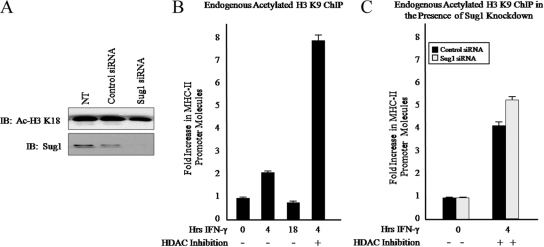FIG. 6.
Sug1 knockdown decreases histone H3 lysine 18 acetylation in a promoter-specific manner. (A) Global histone H3 K18 acetylation is unaffected by Sug1 knockdown. HeLa cells were left untreated (NT) or were transfected with either scrambled control or Sug1-specific siRNA duplexes. Histones were subjected to acid extraction. Lysates were subjected to IB for acetylated H3 K18 (top) or for endogenous Sug1 (bottom). Results reported are data representative of two independent experiments. (B) Histone H3 K9 acetylation at the MHC-II proximal promoter is enhanced upon IFN-γ stimulation and HDAC inhibition. ChIP assays were carried out with HeLa cells stimulated with IFN-γ for 0 to 18 h in combination with HDAC inhibitor (20 h) as indicated. Lysates were subjected to IP with control antibody or with antibody to endogenous acetylated histone H3 K9, and associated DNA was isolated and analyzed via real-time PCR as described for Fig. 2B. IP values are presented as increases in the MHC-II promoter DNA relative to unstimulated acetylated H3 K9 IP sample values. Control IP values were (1.15 ± 0.1)-fold. Control and acetylated histone H3 IP values represent the mean ± SEM of three independent experiments. (C) H3 K9 acetylation at the MHC-II proximal promoter is unaffected by the loss of Sug1 expression. HeLa cells were transfected with scrambled control or Sug1-specific siRNA duplexes and 24 h later were treated with HDAC inhibitor and stimulated with IFN-γ for 0 to 4 h. Lysates were subjected to IP with control antibody or antibody to endogenous acetylated H3 K9, and associated DNA was isolated and analyzed via real-time PCR as described for Fig. 2B. Data are presented as increases in the MHC-II promoter DNA relative to unstimulated acetylated H3 K9 IP sample values. Control IP values were (1.6 ± 0.27)-fold. Control and acetylated histone H3 K9 IP values represent the mean ± SEM of four independent experiments.

